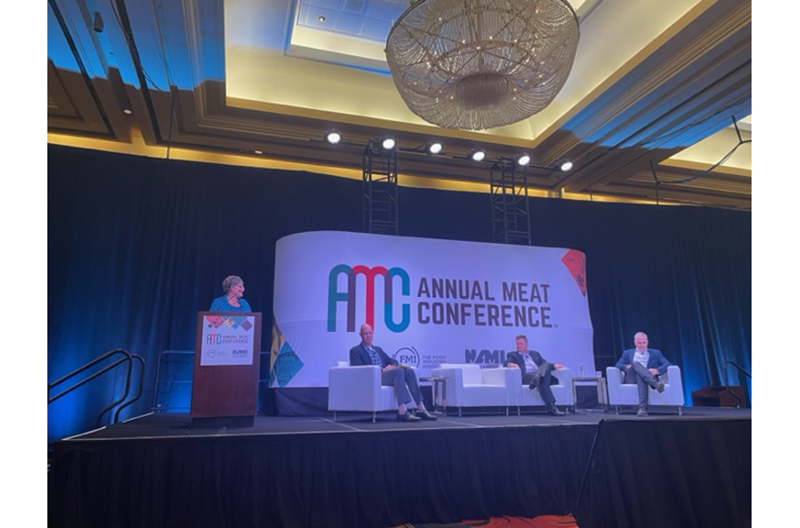Transparency, sustainability, continuous improvement. These topics best describe the “Realizing the Business Value of Supply Chain Transparency” general session during the Annual Meat Conference in Dallas, Texas.
The session featured Barb Renner, vice chair and U.S. consumer products leader at Deloitte; Justin Ransom, senior director of sustainable food strategy at Tyson Foods; and Randy Huffman, chief food safety and sustainability officer at Maple Leaf Foods.
Renner began the session by identifying the “what.” She explained that her consulting firm is working on a number of projects to identify the best avenues for transparency of sustainability.
“We want to see how we might be able to lean into this from an industry perspective, not just an individual company…we have changing needs from the consumer and sustainability has always been a topic for many years.”
The topic of sustainability has become foundational to how companies are perceived. Renner discussed the root causes of businesses either having issues transitioning to more sustainable practices or failing to make their sustainability practices known.
The first stems from incomplete data.
“Everyone talks about having problems getting accessible data, it’s also getting accessible data within your four walls but also with the trading partners that you have. There is also a lack of trust in the system,” Renner said.
She mentioned that ranchers and farmers are less apt to give information to a supplier in fear of how relevant sustainability data could be used against them “versus for them.”
She said this boils down to necessary standardization. Industries need to come together and share information more frequently and openly. The technology for this type of data transparency exists “but it’s not a technology play. The data has to be able to be used in different types of technology.”
The technology needs to be available throughout the supply chain. This would not only help sustainability but also help get the supply chain back on track, according to Renner.
Ransom spoke on sustainability with meat production. He began by citing a report he read that showed $43 trillion in assets is focused around ESG. He noted that emerging governance is requiring businesses to report their emissions. It was previously voluntary. He said this will only benefit producers.
“It’s really about, as this becomes a regulatory environment, how do we as businesses think through what we need to do to be able to successfully report? Then, as you think about the consumer, there’s an opportunity to grow customer trust.”
These regulations would allow sustainability efforts to become more widely known if businesses understand how to share them effectively. Ransom particularly noted the younger demographic, which is becoming more environmentally conscious. This awareness has proven to affect the way the next generation shops.
“It’s empowering to know that there is a demographic that is going to be interested in that…because they share the company vision and values,” he said. “I think all of these things combined just creates a huge opportunity for us to find ways where we can use sustainability and ESG in our business that creates shared values across the value chain.”
He admitted that implementing sustainable practices and executing them on a company-wide scale will take time and energy.
“It’s really about going through a robust materiality assessment, asking everybody from investors, to customers, to frontline team members, executives, and making sure that we’re clear on what is important for the organization.”
Then it comes down to building a long-term strategy. Again, Ransom said this is where companies run into the most issues. They have difficulty thinking outside of the “traditional cycle” of 24-36 months. These types of questions, issues and strategies require thinking 10 or more years down the road, he said.
In addition, strategies must include short- and long-term goals that will not help companies know their strategies are on track and also enable them to showcase various accomplishments with consumers.
This all starts with data. Tyson Foods has undertaken the data acquisition process, but it takes “three-and-a-half hours” to get one cow through the emissions.
Over the past two years, Tyson has been attempting to achieve “climate neutral beef.” After an initial study was done, the company discovered that 70 percent of its enterprise emissions comes from its beef industry. It is attempting to understand what comprises that percentage.
“It’s really a journey that has been founded in science,” Ransom said. “There’s acknowledgement that there’s opportunities that we need to continue to find ways to connect the value chain, connect data and pull it through in a way that has shared value throughout the whole chain. We’re sharing data back, it’s a bi-directional flow of data.”
Sharing data between producers and suppliers can help find the most “leaks” and best practices.
Huffman was the final speaker of the session. His company, Maple Leaf Foods, is one of the largest food processors in Canada. It has taken some of the steps that Ransom highlighted earlier. While he did not go into much detail, he spoke about the company’s purpose – “raising the good food.”
“We chose those words carefully,” he said. “The word ‘raised’ talks about continuous improvement, which is something that we’re super committed to.”
The company wants to become the “most sustainable protein company on Earth.” When that commitment was made five years ago, he said the company’s administration was “a little nervous.”
“That is a bold commitment to make. And it’s not meant to be boastful. It’s meant to set the bar high for people,” Huffman said.

